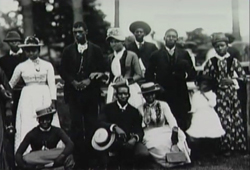Teachers' Domain - Digital Media for the Classroom and Professional Development
User: Preview

Source: The Rise and Fall of Jim Crow: "Fighting Back"
Wilmington, North Carolina,1898: Prelude to a Riot: Transcript (Document)
In 1898, Wilmington, North Carolina, located in eastern Carolina where the Cape Fear River enters into the Atlantic Ocean, was a prosperous port town. Almost two-thirds of its population was black, with a small but significant middle class. Black businessmen dominated the restaurant and barbershop trade and owned tailor shops and drug stores. Black people held jobs as firemen, policemen and civil servants.
A good feeling between the races existed as long as white Democrats controlled the state politically. But when a coalition of predominately white Populists and black Republicans defeated the Democrats in 1896 and won political control of the state, angry Democrats vowed revenge in the election of 1898. For many Democrats, black political power, no matter how limited, was intolerable. Daniel Schenck, a party leader, warned, "It will be the meanest, vilest, dirtiest campaign since 1876. The slogan of the Democratic Party from the mountains to the sea will be but one word… nigger."
The Democrats launched their campaign by appealing to the deepest fear of whites -- that white women were in danger from black males. The white newspaper in Wilmington published an inflammatory speech given by Rebecca Felton, a Georgia feminist, a year earlier: "If it requires lynching to protect woman's dearest possession from ravening, drunken human beasts, then I say lynch a thousand negroes a week…if it is necessary." The article infuriated Alex Manly, a Wilmington African-American newspaper editor. He replied by writing an editorial sarcastically noting that many of these so-called lynchings for rapes were cover-ups for the discovery of consensual interracial sexual relations. The Manly article fueled raging fires.
White radicals vowed to win the election by any means possible. Although black voters turned out in large numbers, Democrats stuffed the ballot boxes and swept to victory throughout the state. But in Wilmington, the political victory did not soften white fury. Whites drove all black officeholders out of office. A mob set Manly's newspaper office on fire and a riot erupted. Whites began to gun down blacks on the streets. Harry Hayden, one of the rioters, asserted that many within the mob were respectable citizens. "The men who took down their shotguns and cleared the Negroes out of office yesterday were not a mob of plug uglies. They were men of property, intelligence, culture…clergyman, lawyers, bankers, merchants. They are not a mob. They are revolutionists asserting a sacred privilege and a right." By the next day, the killing ended. Officially, 25 blacks died but hundreds more may have been killed, their bodies dumped into the Cape Fear River.
--adapted from the website The Rise and Fall of Jim Crow
 Loading Standards
Loading Standards